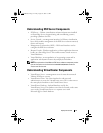
Deployment Guide 7
Understanding Dell Configurations
For this release, Dell has qualified a base server configuration for use with
ESX Server 2.1.2 software. A single server can be used in a "stand-alone"
mode, or one or more servers can be connected to a shared SAN through a
switch. VMotion technology is available when two or more servers share a
common SAN. VirtualCenter may be used to manage servers in any of these
configurations, and is required to initiate VMotion events.
NOTE: USB devices are not supported with ESX Server 2.1.2 software default
installation and configuration. Even if USB is enabled in the BIOS, the
ESX Server 2.1.2 software will disable it by default. If you need to use USB with
ESX Server 2.1.2, see the VMware knowledge base article 1326 - Using USB
When ESX Server Disables It.
The following tables list Dell's recommended configurations.
Ta bl e 1 -1
shows the common baseline configuration. For standalone configurations,
add the contents of
Ta bl e 1 -2
to that of
Ta bl e 1 -1
. For SAN-attached
configurations, add the contents of
Ta bl e 1 -3
to that of
Tab le 1- 1
.
Table 1-1. Base ESX Server System Hardware Configuration
Device
Class
Configuration Configuration Configuration
Server PowerEdge 6650 PowerEdge 2850 PowerEdge 1850
Processor Four Intel Xeon
Processors
Two Intel Xeon
Processors
Two Intel Xeon
Processors
RAM 16 GB
(recommended)
8 GB
(recommended)
8 GB
(recommended)
RAID
Controller
PowerEdge
Expandable Raid
Controller 4, dual
channel
(PERC4/DC)
PowerEdge
Expandable Raid
Controller 4e/Di
(Dual Channel
Integrated)
PowerEdge
Expandable Raid
Controller 4e/Si
(Single Channel
Integrated)
Networking Two Integrated
Network Ports
Add-On NIC
Two Integrated
Network Ports
Add-On NIC
Two Integrated
Network Ports
Add-On NIC
X6320bk0.book Page 7 Friday, August 27, 2004 1:35 PM


















